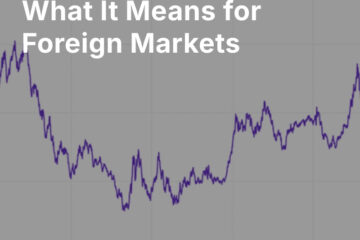In the period since the end of the Great Recession, the U.S. stock market has moved ahead — while emerging-market stocks have spent almost a decade basically treading water.
Emerging Markets Have Underperformed the U.S. In the Post-Crisis Period

Source: Bloomberg LLP
For a time, beginning partway through 2016, the global economy was “firing on all cylinders with every member of the Organization for Economic Cooperation and Development (OECD) in
Over the course of 2018, several potential problems and sources of investor anxiety began to emerge:
First, investors began to fear that the Federal Reserve would be too aggressive in its tightening; they thought that interest rates would be rising on autopilot regardless of whether the economy was strong enough to handle the increases, and that this might accidentally tip the U.S. into recession in the near future.
Second, investors fretted about the potential fallout of the ongoing trade conflict between the U.S. and China.
And third, investors worried that an economic slowdown in China — partly the fallout of trade conflicts, and partly due to China’s own internal troubles — might have negative effects on the economies in the rest of the world, whose health is closely linked to Chinese demand.
All three concerns came to a head at the end of 2018, resulting in sharp declines in many global stock markets. These concerns did not exist in a vacuum — there were real events and real trends that were triggering them, even if those events and trends did not yet warrant the level of alarm that market participants had.
What A Difference A Few Months Can Make
Stock markets inflected sharply upwards after the crescendo of selling in December. On January 4, Fed Chair Jerome Powell indicated the Fed’s patience in raising
Throughout the first quarter, other data gradually came in to support the view, which we expressed in these pages since last year, that the observed deceleration in growth in many of the world’s economies would trough in the first half of 2019, and then reaccelerate into the second half of the year. We believe that stock markets in the U.S. and in China, in particular, spent the first quarter of 2019 pricing in that inflection of global growth back towards an
What’s Happening To Move the Global Growth Needle
First, as we noted above, the Fed has clarified its position and reiterated data dependence moving forward. Most analysts now anticipate zero or one rate increase in 2019. Inflation remains restrained; the Fed could raise rates in December if growth accelerates notably and inflation begins to appear. However, some believe that the Fed’s next move will be to cut rates.
Further, Chairman Powell, commenting in his testimony before Congress in February, noted that the Fed’s inflation goal is — that is, they’re shooting for a long-run average of 2
Second, China’s growth is turning up. China began a fiscal easing process in earnest last year, in response to domestic economic deceleration and to the threat posed by trouble with trading partners — not just the U.S., but quietly, other developed-world markets as well. Recently, that fiscal easing has intensified. The recent National Peoples Conference (NPC) enacted larger-than-expected value-added tax (VAT) cuts, increased the quotas of local governments to issue infrastructure bonds, and reduced the social security contribution that firms make for employees.
In response to these and other stimulus efforts, credit growth has
As we’ve noted in recent letters, China has also increased its efforts to attract foreign capital — something that China’s rulers know will become increasingly important as the Chinese economy continues to mature over the coming decade.
On balance, this stimulus — occurring through mechanisms such as tax cuts and bond issuance — means that less stimulus will be coming through the channels of the unofficial, or shadow banking sector. That’s in harmony with the desire of China’s leaders to continue slowly reining in the excessive debt and leverage that built up in China’s financial system over the past two decades.
Why Emerging Markets Make Sense
PMIs for some emerging markets
Chinese PMI leads that of many other countries and regions. In an era of increasingly integrated global supply chains, China sits in a position where its demand for raw materials and intermediate goods is highly influential on many of the world’s developing economies. We would anticipate that if Chinese PMI acceleration continues, we will increasingly see PMIs in the emerging markets accelerate also in
In China, Fixed-Asset Investment Has Inflected Up

Morgan Stanley Research
As we noted at the top of this piece, emerging-market stocks have experienced a long period of underperformance. We know that cœreversion to the mean almost always happens eventually — but what could cause the long-awaited EM catch-up?
First is the Chinese stimulus, as noted above, which is already having an effect, and as it gathers momentum, Chinese demand will percolate throughout the countries we’ve referred to as its workshops (countries such as Thailand and Vietnam).
Second is the possibility that the globalization ushered in by the global wave of populist and nationalist sentiment may work to help many emerging-market economies, especially in China’s neighborhood. A company executive who thought to open three factories in China might now see that the risks are sufficient to warrant opening a factory each in Cambodia, Thailand, and Vietnam (or, if Narendra Modi’s reforms continue, perhaps India). This could help intensify the established trend of lower-end manufacturing migrating out of China in search of cheaper wages and currencies.
Third is simply that emerging-market stocks have underperformed for so long that they are relatively cheap — at historical extremes of valuation difference with developed-market stocks.
We believe that the stars may indeed begin to align for emerging markets in 2019.
Investment implications: Investors should remember, as we often reiterate, that the domestic Chinese stock-market is driven by investor sentiment, not by fundamentals. That sentiment can drive rallies in the absence of fundamentally positive



